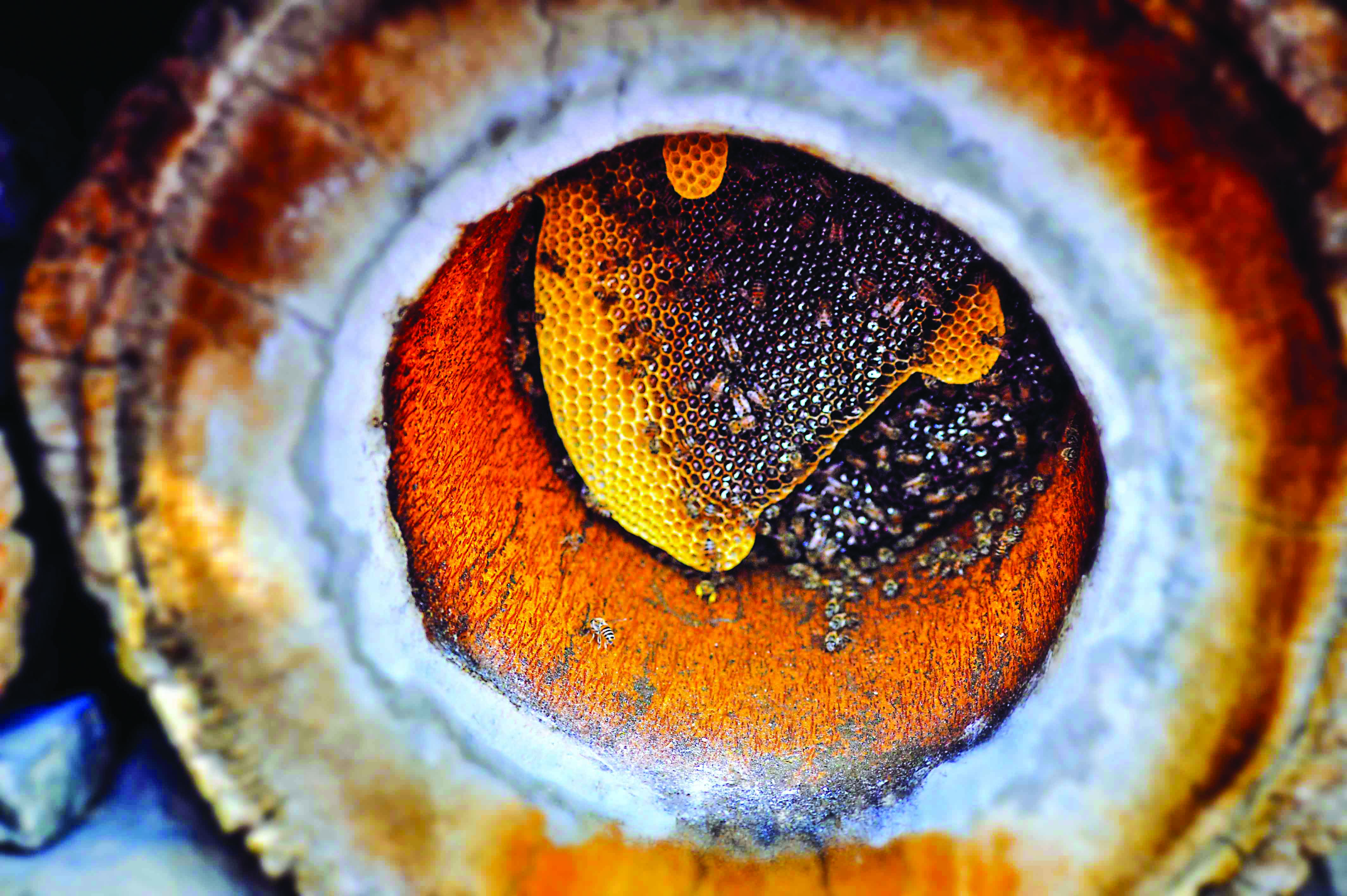
In Jifr, a village in Wadi Bani Awf on the foothills of Al Hajar Mountains, famous for bee keeping, the farmers use the traditional Omani method of beekeeping. Khamis, a prominent beekeeper led us to his colony of bees, which he has been keeping in rows of dried emptied palm trunks roofed with date palm leaves.
He uses a typical kind of piece of wood to smoke the bees away. It is called ‘usbuq’, root of a tree found in the mountains. These palm tree trunks maintain a perfect temperature for the bees during cold winter in the mountain and the Omani hot summer. With a small knife Khamis cuts a piece of the honeycomb from one of the trunks, carefully not agitating the bees. Khamis and his brothers Sayd and Nasar do keep bees for a living. In their majlis, Nasar cuts a piece of honeycomb for us. Not only for Khamis and family, but for many villagers beekeeping is a main source of income. The fresh, tingling natural honey is something you will never get from the supermarkets. This local honey is so uniquely flavoured and sweet. “Those who know this taste will buy this mountain honey paying many times the supermarket price,” said Khamis. Beekeeping has been an art form passed on for many generations in the foothills of the Hajar Mountains. There's something special to savour experiencing it straight from the comb. According to him, honey has therapeutic powers and the Arabic name for bee is ‘nahlat’, which means a gift of God.
Now the Ministry of Agriculture and Fisheries has put in efforts and implemented many projects into the research to help enhance the production of honey, since honeybees have a significant role in the economic development of the farmers. According to the ministry officials, the ministry has made many efforts to upgrading honey bees by implementing many programmes such as Omani Dynasty Programme. The ministry published the Omani dynasty Programme, which aims to disseminate the Omani dynasty through the distribution of honey bee colonies to beekeepers. Another programme focuses on the production of the largest amount of queens. The ministry had conducted seminars and training courses for beekeepers in which the farmers get trained about the correct ways of breeding and propagating of honey bees.
Honey Bees
There are two types of honey bees in the Sultanate — Omani domesticated bees: Apismellifra and Omani Dwarf bees (Abu Twaiq): Apisflorea. The domesticated bees are considered the predominant type in the Sultanate and have a historic connotation with the Old Omani Beekeeper. It is believed that in his writings, Imam Saif bin Sultan has introduced this type of bees about 400 years ago. Omanis who have kept this kind of bees in the cavities of the logs of palm trees also started to keep them in modern hive boxes from the mid-seventies of the last century, and spread this species of bees in all governorates. According to the ministry figures, there are 4,433 beekeepers who practice this conventional method and produces around 434,622kg of Omani honey.
The Omani Dwarf bees are relatively small, so the amount of honey being produced from this bee is also low when compared to the first type. The price of this precious honey is higher because the Dwarf bees are a wild variety that live in the caves of the mountains during winter and come down to the gardens and farms in the summer. There are many varieties of honey, but the finest variety is ‘Al Baram’, or ‘A’Sumar, named after ‘Acacia tortilis’, which is usually light black in colour. The Sidr honey, which is light brown in colour, is also high in demand. Honey is collected throughout the year, but the fine quality honeys are those produced from March until the end of May.
Omani Honey Market
The sixth Omani Honey Market, which was opened on Wednesday at the Muscat Grand Mall, will end on Saturday. Around 62 beekeepers from different governorates are participating in the market. Sumer honey, Sidr honey, Shooa honey, Luban honey and many other unique types of honey and honey products are there. The ministry has been organising such honey expos with a view to popularising Omani honey in the local as well as global markets. The Ministry of Agriculture and Fisheries (Honey Bees Department) has opened a stall at the venue to give some knowledge to the visitors.
—[email protected]